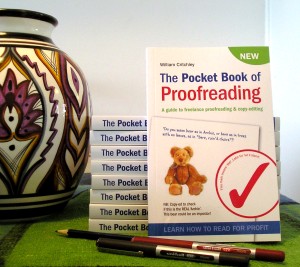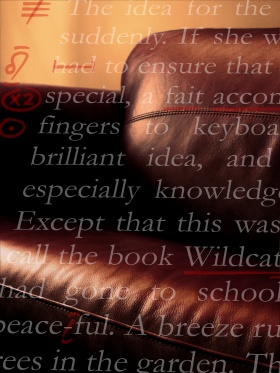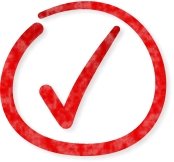Read the Special Report
Click here to read the Special Report from William Critchley.
This report introduces the course and describes some of its history, as well as giving some insight into the proofreading profession.
More about the book

No previous experience or special skills are needed – just an eye for detail and the determination to succeed.
The Pocket Book of Proofreading’s 262 pages are full of easy-to-follow tips to help you succeed as a freelance proofreader and/or copy-editor.
This book was based on an original idea and course known as 'Freelance MS'. This course was actually the very first proofreading course on the market, and it was a bestseller.
The new Learn Freelancing Proofreading and Copy-editing Course is the latest course developed from the original and it can be downloaded here!
The idea of a freelance proofreading and copy-editing course, providing an opportunity to work from home, full or part time, has been copied by many other businesses and organisations, some of them less than scrupulous.

Don’t forget it’s suitable for beginners too. One of our most successful course applicants (a retired wing commander) had no previous experience but was soon proofreading from a cottage in Wiltshire for a famous London publishing house.
Have a look at the list of contents.
Before starting work on Learn Freelancing's new Proofreading and Copy-editing Course, you will first have to read the information in the book: you need the book in order to complete the course.
NB: The Pocket Book of Proofreading is now available as a Kindle download!
Excellent recent comments about The Pocket Book of Proofreading
Dear William Critchley
I have found your book interesting and useful, and I am about to embark on the major exercise on the website.
As I read the book, I came across a number of mistakes, and I began to think that I would find a list of 'did you spot?'s in the closing pages. Your addenda did pick up a few of them, but there are several others, which I can only suppose escaped your attention and that of your proofreader. The first one, on p. 16, does seem a little egregious.
My list is attached, and I shall be interested in your response to it.
Yours sincerely
Charles Martin
COMMENTS ON THE POCKET BOOK OF PROOFREADING
|
Page reference |
Comment |
|
p. 16, para 3 |
‘…no one could, or should have, “updated” Archibald…’ Misplaced comma – should read ‘could, or should, have…’ Easily checked by reading the sentence without the words in parentheses. |
|
p. 64, para 1 |
‘…when used adjectivally, and not as titles, of political parties.’ Comma distorts sense – should read ‘…not as titles of political parties.’ |
|
p. 65, para 2 |
‘…(but chauvinism), venetian.’ Misplaced end bracket – should read ‘…(but chauvinism, venetian).’ |
|
p. 71, para 2 |
‘aeroplanes’ in penultimate line, ‘airplanes’ in last line. Be consistent – UK or US use, not both, especially in adjacent sentences. |
|
p. 85, para 2 |
‘...ibid. may, or may not be, in italics.’ Misplaced comma – see p. 16 note above. |
|
p. 92 |
Inconsistent use of numbers expressed in numerals and letters. ‘2 ems, three ems’. |
|
p. 108, para 4 |
‘…using a reference letter…’ ‘…same reference number…’ Inconsistency. |
|
p. 132, penultimate bullet point |
‘Ring’ here used as a collective noun. As such it may, or indeed here should, take a plural verb. See Fowler. |
|
p. 185, para 3 |
‘Be what you are.’ Misplaced full stop – should read ‘Be what you are’. |
|
p. 188, para 1 |
‘…pension size…’ Size was italicised in the exercise; it should remain so now, and be included in the correction. |
|
p. 189, para 2 |
‘In a well nearby was found an icon..and a bronze cross.’ ‘Was’ should be corrected to ‘were’ – icon and cross comprise a plural subject. |
|
p. 196, passim |
‘Katherine’, not ‘Kathryn’. |
|
p. 202, para 4 |
‘ref-erences’ ‘refer-ences’ would be a better word break. |
|
p. 216, para 5 |
‘…the most 25th inferlential person…’ Should be ‘…the 25th most inferlential person…’ |
|
p. 225, para 2 |
This is a most interesting point. One would instinctively refer to ‘a big red bus’ rather than ‘a red big bus’. Or, as in the text, ‘a small yellow minidress’ rather than ‘a yellow small minidress’. This suggests that the colour of an object is a more significant characteristic than its size or its shape. Does this govern whether there should be a comma between the adjectives or not? |
Thank to Charles for the above! Excellent comments re my errors!

